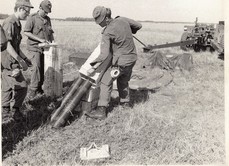MILCON 73
MILCON 73 Shilo, MB
By Capt. JA Davidson
Scarcely had the dust settled from our early return to Shilo after WAINCON when the regiment had to prepare for MILCON 73. All the Militia units from Kenora to Victoria arrived in Shilo on 30 June and 1 July to prepare for a full week of competitions, troop and battery shooting, and fire planning. The units formed three batteries and filled several RHQ appointments. The batteries were composed of the following units:
RHQ 26 Field Regiment, LCol Brown, 20 Fd Regt CO Milcon 73.
P Bty 20 Field Regiment, 10 Field Regiment, and 10 Independent Battery.
Q Bty 15 Field Regiment and 5 BC Field Battery
R Bty 26 Field Regiment and 116 independent Battery.
Each battery underwent a series of refresher tests designed to identify problem areas and define battery standards. The batteries then began a day and a half of troop and battery commander’s fire and movement exercises. Competitions were also held during this period. Q Bty won the lion’s share of the award with Sgt Rodgers of R Bty winning the best detachment competition.
At 1900 hrs, 3 July, the MILCON CO held his O Group for Exercise Powder Keg IV. This exercise was a two and a half day, regimentally controlled, fire and movement exercise. BC’s and TC’s fire plans and CP operations were tested throughout. 3 RCHA provided a DS team for each battery to advise and prepare final reports. Powder Keg IV finished with a regimental fire plan; thus, bringing the most successful MILCON to date to a fitting finish. Friday afternoon was spent turning in equipment and clearing preparatory to National Royal Canadian Artillery (Militia) Summer School.
The militia units showed that their performance has improved greatly since MILCON 72. Units had strived to correct last year’s faults and the final results indicated that Local headquarters training had been properly used. With this spirit, militia units should be prepared to conduct regimental level fire planning for MILCON 74. The close working relationship between militia units and RSS Staff with 3 RCHA has been instrumental in raising the proficiency of Western Canadian Militia Artillery Units. Future milcons and the continual attachment of militia personnel to 3 RCHA will now refine the skills learned on MILCON 73.
The Canadian Gunner 1973, Volume 9, December 1973, page 52
By Capt. JA Davidson
Scarcely had the dust settled from our early return to Shilo after WAINCON when the regiment had to prepare for MILCON 73. All the Militia units from Kenora to Victoria arrived in Shilo on 30 June and 1 July to prepare for a full week of competitions, troop and battery shooting, and fire planning. The units formed three batteries and filled several RHQ appointments. The batteries were composed of the following units:
RHQ 26 Field Regiment, LCol Brown, 20 Fd Regt CO Milcon 73.
P Bty 20 Field Regiment, 10 Field Regiment, and 10 Independent Battery.
Q Bty 15 Field Regiment and 5 BC Field Battery
R Bty 26 Field Regiment and 116 independent Battery.
Each battery underwent a series of refresher tests designed to identify problem areas and define battery standards. The batteries then began a day and a half of troop and battery commander’s fire and movement exercises. Competitions were also held during this period. Q Bty won the lion’s share of the award with Sgt Rodgers of R Bty winning the best detachment competition.
At 1900 hrs, 3 July, the MILCON CO held his O Group for Exercise Powder Keg IV. This exercise was a two and a half day, regimentally controlled, fire and movement exercise. BC’s and TC’s fire plans and CP operations were tested throughout. 3 RCHA provided a DS team for each battery to advise and prepare final reports. Powder Keg IV finished with a regimental fire plan; thus, bringing the most successful MILCON to date to a fitting finish. Friday afternoon was spent turning in equipment and clearing preparatory to National Royal Canadian Artillery (Militia) Summer School.
The militia units showed that their performance has improved greatly since MILCON 72. Units had strived to correct last year’s faults and the final results indicated that Local headquarters training had been properly used. With this spirit, militia units should be prepared to conduct regimental level fire planning for MILCON 74. The close working relationship between militia units and RSS Staff with 3 RCHA has been instrumental in raising the proficiency of Western Canadian Militia Artillery Units. Future milcons and the continual attachment of militia personnel to 3 RCHA will now refine the skills learned on MILCON 73.
The Canadian Gunner 1973, Volume 9, December 1973, page 52
Det Comd Sgt Richard Van Slyke
Driver Bdr Leon Jensen
Gun Number Gunner Darren Kostinuk
Driver Bdr Leon Jensen
Gun Number Gunner Darren Kostinuk
